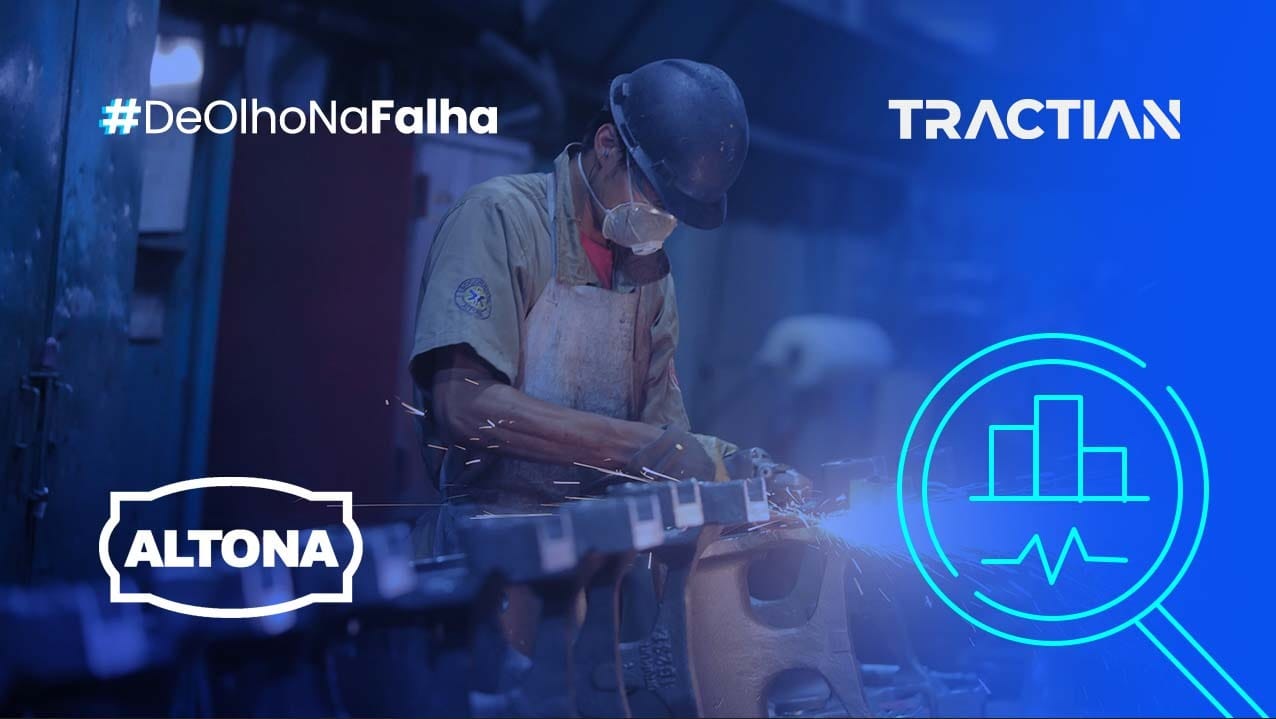Eye on Failure is a series of maintenance stories about professionals who implemented our solution and were saved from sudden breaks and interruptions to production. To know about other cases, such as Embraer and AmstedMaxion, visit our blog.
A global reference in foundry and machining, Electro Aço Altona, from Santa Catarina, has existed for almost a century and is among the largest Brazilian companies in the segment, exporting to over 25 countries.
As a national and international supplier of fundamental parts for several sectors, Altona invests resources and efforts in predictive maintenance to ensure that the operation runs as expected. However, it took a while for the team to find a solution that met all the needs of its asset management.
Check out our complete guide to Predictive Maintenance
According to Fabian Odebrecht, the maintenance manager, the team had several problems with vibration analysis before coming across TRACTIAN. This is because the data was collected monthly and manually, generating data with unsatisfactory reliability - and, consequently, not very assertive analysis and maintenance strategies.
Felipe Lunelli, maintenance analyst at Altona, says that the predictive routine used to be like this: the specialist came to the plant once a month, collected data from the equipment, and passed it on to the team. They then attached the information to an Excel spreadsheet and followed up the changes based on that data.
“But it was not possible to do this for all the assets, especially because the condition can change a lot from one day to another. In the exhaust fans, for example, just by releasing a weight the next day would already be unbalanced, and the technician would only get this data the following month. And in the meantime, the equipment would break down.”
Guided by the offline method, the company’s maintenance was at the mercy of outsourced predictive maintenance and spaced vibration analyses, also suffering from the absence of an accessible database to monitor the machines’ behavior and define more assertive strategies.
Offline and Online Predictive Maintenance: learn the difference
Fabian recalls that he was looking for something on the market that would make the day-to-day work of Altona’s team easier and make the maintenance process more reliable. And so, searching for online monitoring solutions, he found TRACTIAN and decided to give it a try.
At first, with 20 Smart Trac sensors concentrated in the mixers - the most critical assets in the plant - Altona’s maintenance staff was somewhat suspicious of the devices’ accuracy.
“We wanted to see if the solution was really assertive, so we didn’t pay attention to several insights at the beginning. If we didn’t see anything abnormal in the equipment, we left it, despite the alerts… Until we had a surprise: the first breakdown of a critical piece of equipment, detected in time by the platform,” reports Adão Juliano, leader of the maintenance team.
The machine in question was a high-critical asset, an IMF sand mixer, and one of the main machines in the molding process. After receiving an unbalance insight in the main shaft of the equipment, the technicians went to the asset and verified that there was indeed a gap in the coupling between the shaft and the engine.
Thus, they scheduled the intervention for a time that would not affect production, since the downtime of such a machine would cost 4 to 5 productive hours. They avoided both the unexpected breakdown and the downtime in the operation.

Adão says that this episode served as proof for the technicians as to the accuracy and efficiency of the sensors. “We realized that the solution was really reliable and brought results and, therefore, we had to learn to trust the analysis made by the system,” he says.

The platform, besides issuing the insight and alerting the team about the failure and its possible causes, allows the alert to be managed by the person responsible. In the image above, Adão Juliano changed the status of the Insight after the correction and added information about the procedure.
And the confidence was great to the point that they decided to double the sensor fleet in the plant. Fabian says that, after the mixer episode, they exported the data from the platform and took it to Altona’s board of directors to convince those responsible to increase the investment. By presenting the results and the efficiency of the solution in avoiding costly emergency corrections for maintenance, they went from 20 to 41 sensors, doubling the number of points monitored.
Some of the monitored assets are:
- 10 air compressors;
- 6 sand mixers;
- 12 dust collectors;
- 2 front bearings;
- 1 manipulator;
- 5 exhausters;
- 2 motors;
- 1 blower;
- 1 belt.
The maintenance leaders even tested other online monitoring sensors, but, according to Felipe, none of them had a “full-time” platform like TRACTIAN’s, which allows the database to be accessed from anywhere, any time of the day, as well as prescriptions and analyses.
The maintenance analyst explains that, before, he never had enough data to take to the manager in meetings, because the collections were done monthly. Likewise, he could never identify potential failures in time, only when the asset was about to stop.
On the other hand, today Felipe Lunelli can follow up daily on what is happening with the machine through the platform, always taking precise data to the manager and showing him why it is interesting to intervene in such equipment at that moment.
-------------------------

“When I get to Altona, one of the first things I do is open the TRACTIAN platform and see how the machines are behaving if they are going to break down or something like that. For me, as an analyst, it has become a basic tool to have my analyses and to be able to show them to the managers.”
What he says refers to the Altona maintenance team’s habit of monitoring the health and behavior of the machines all the time, rather than just waiting for insights from the system. He goes through all the equipment by looking at the Analytics tab of the platform and comparing it one by one with the previous days. When he notices any changes, the technician analyzes the data for possible intervention.
Adam agrees with his colleague about the importance of knowing everything that is happening with the machinery, which for him becomes even easier with the TRACTIAN App.
For the maintenance team leader, asset management is much more practical because it fits inside his cell phone and can be followed anywhere. He says he is often in the plant or in another location, sometimes even during lunch, and the platform is always sending warnings about changes in indicators and potential failures.
The best thing, according to Adão, is that the team can immediately respond to the notification, make an observation, and schedule maintenance, all through the app.
More than the insights and automatic analyses, the technicians of Electro Aço Altona found in TRACTIAN’s predictive system a way to be in continuous contact with their equipment, knowing in depth their behavior without depending on spaced and inaccurate vibration collections.
For the manager Fabian, the result is more than satisfactory, since many stops and breaks were detected at the potential stage thanks to the monitoring via platform, which avoided high costs of production downtime.
Just like the foundry and machining giant, your industry can also multiply its maintenance results with the right tool. Talk to one of our experts and understand how the TRACTIAN online asset management and monitoring system will give you total control over your machines and processes.

